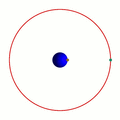Geosynchronous orbit facts for kids
A geosynchronous orbit is an orbit at a height of 35,786 km (22,000 mi) above sea level on the Earth. At this height, the orbit takes 24 hours, so it is in sync with the land on Earth (the 'geo' part of geosynchronous).
The geostationary orbit is the most common type of geosynchronous orbit. This is right above the equator, so the satellites in this orbit do not swing north or south, but stay perfectly still above a point on the equator. This is useful for communication satellites (including satellite TV).
Geosynchronous also includes orbits that are not above the equator, but since every orbit goes around the center of the Earth, the satellite must spend an equal amount of time north of the equator as it does south of the equator, so it appears to slide up and down when viewed from the Earth.
Images for kids
-
The geosynchronous orbit was popularised by the science fiction author Arthur C. Clarke, and is thus sometimes called the Clarke Orbit.
-
A quasi-zenith satellite orbit
See also
 In Spanish: Órbita geosíncrona para niños
In Spanish: Órbita geosíncrona para niños








